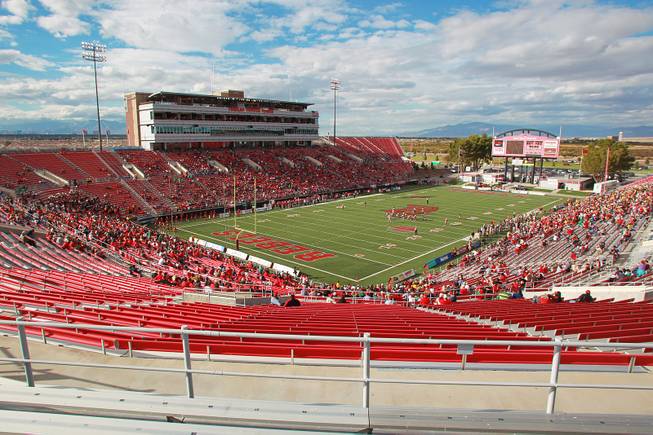
Sam Morris / Las Vegas Sun
A sparse crowd attends the UNLV vs. Wyoming football game Saturday, Nov. 17, 2012 at Sam Boyd Stadium.
Thursday, Dec. 12, 2013 | 6 p.m.
An on-campus UNLV football stadium should seat at least 50,000 people and have a Teflon-coated inflatable cover.
The next step
Later this month, the UNLV Stadium Authority is expected to hire a project manager who will oversee the design process for the on-campus football stadium.
The state received nine bids for the project manager position. The state’s purchasing department will review the bids and make a recommendation to the stadium authority. Board members are expected to vet the candidates at its Dec. 20 meeting and choose a suitable manager.
Here are the nine companies vying for the position:
• Barrett Sports Group LLC, from Manhattan Beach, Calif.
• BW Realty Advisors LLC, from Washington, D.C.
• Convention Sports and Leisure International, from Plano, Texas
• Hammes Company Sports Development Inc, from Madison, Wisc.
• JMI Sports LLC, from San Diego
• Jones Lang Lasalle Americas Inc., from Las Vegas
• Nations/Wright from Scottsdale, Ariz.
• Price Waterhouse Coopers LLP, from Tampa, Fla.
• Sterling Project Development Group, LLC, from Flushing, N.Y.
That’s according to stadium consultant Mark Rosentraub, who advised the UNLV stadium board on Thursday about the proposed project’s scope.
Rosentraub, a University of Michigan sports management professor, presented a list of stadium and arena projects from around the country and urged board members to consider worthy parts of some projects and discard others that didn’t “maximize the fan experience.”
As high-definition televisions and surround-sound systems become cheaper and more widely adopted, the fan experience at stadium events becomes more important, Rosentraub said. Stadium developers are now reconsidering excessively large stadiums with poor sight-lines in favor of smaller stadiums that incorporate iconic architecture and “social spaces” that enhance the fan experience, he said.
UNLV should nix the notion of a 100-foot-long video screen, a feature that was prominently touted in the last iteration of the UNLV stadium concept. Building the “world’s largest video screen” is expensive and would detract from the live experience of watching a football game, Rosentraub said.
Rosentraub pointed to the Dallas Cowboys Stadium, which currently has the world’s largest video screen. Instead of watching the football game, Cowboys fans end up watching TV screen — something they could do at home.
“Why come to the game?” Rosentraub asked rhetorically. “I’m not sure this is something we want.”
Instead of a 60,000-seat “mega-events center” with the world’s largest video screen, Rosentraub argued that UNLV should focus on building “social spaces” that can serve as a tailgating space for fans. Rosentraub said UNLV should consider the Baylor University or the University of Washington football stadiums, which incorporate a large plaza and glass design that invites fans and students in.
To entice fans to attend games, UNLV must build an iconic stadium that complements the iconic features on the Las Vegas Strip, Rosentraub said. The Minnesota Vikings stadium, which also features large glass walls, is an eye-catching feature that can’t be replicated in home theater systems, he said.
Size-wise, the UNLV stadium should be larger than Sam Boyd Stadium, which seats 40,000, but not too large that sight-lines suffer, Rosentraub said. UNLV should consider a stadium that has at least 50,000 seats and has several tiers so that UNLV could host major bowl games.
For the university to be able to host events year round — particularly in scorching desert summers — the UNLV stadium should be covered, Rosentraub said. He recommended that the stadium authority look at the cost of building a Teflon-coated inflatable stadium cover — an updated version of Syracuse University’s Carrier Dome. Rosentraub, however, didn’t rule out a domed stadium, which could add between $50 million and $100 million to the project’s overall construction costs.
The UNLV Campus Improvement Authority Board will take Rosentraub’s recommendations to a project manager, who — once hired next month — will be responsible for writing an interim report that must be submitted to the Nevada Legislature by next September. The report will outline the size and amenities of the UNLV stadium, and how the university plans to finance the project.
Rosentraub, who has 30 years of experience in sports management, authored a UNLV-commissioned report last year that found an on-campus football stadium that doubles as an events center and has a 55,000-seat capacity could infuse nearly $400 million into the local economy.

Join the Discussion:
Check this out for a full explanation of our conversion to the LiveFyre commenting system and instructions on how to sign up for an account.
Full comments policy